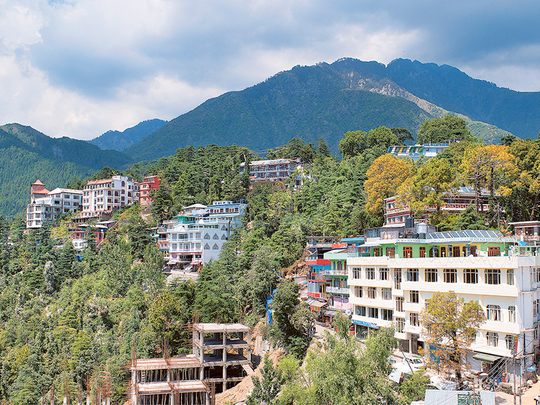
McLeodganj (Himachal Pradesh): This once-peaceful abode of Tibetan spiritual leader Dalai Lama, with the Dhauladhar ranges in the backdrop, is rapidly turning into a concrete jungle with massive constructions underway to cash in on the tourism boom.
Experts fear a high-intensity quake can turn this quaint uphill town, known for attracting a steady stream of Tibet enthusiasts, Buddhist scholars, backpackers and even Hollywood stars, into a tomb of rubble as it falls in seismic zone V, suggesting severest seismic sensitivity.
“It was once a small village of shepherds. Now you can see a concrete jungle all over,” local resident Joginder Singh told IANS.
He said that much of the commercial activity around McLeodganj is a result of people cashing in on the tourism boom.
Joginder Singh is the caretaker of one of the oldest landmarks, Nowrojee and Sons General Store, that was set up in 1860 to take care of the daily requirements of the British officers and their families. It has maintained its original grand wooden structure.
“Most buildings are clinging to one another. Even a moderate earthquake can be catastrophic for these buildings with no escape routes. They can collapse like a pack of cards,” tourist James McClarence from Britain told IANS.
He said colonial British India exists now only in Kipling’s novels.
Old-timers in McLeodganj, which remained almost uninhabited until the arrival of the Dalai Lama along with his followers in 1960, remember the town with much affection.
“McLeodganj has lost its British colonial charm of Gothic-style of architecture in buildings and letter boxes in cylindrical and pillar shapes,” said octogenarian Naresh Chauhan, who has lived here since childhood.
Earlier, he said, most of the constructions were of mud, adobe and random stones.
“Such structures are liable to suffer partial damage in the wake of quakes. Now most of them are concrete and may have ignored the traditional practices of seismic proofing such as ‘dhajji’ and incorporation of wooden beams,” he added.
This town — the political, cultural and spiritual hub of the Tibetan diaspora — in Kangra district supports around 16,000 exiled Tibetans and an equal number of Indians.
A devastating earthquake in 1905 severely damaged property in the Kangra region, including St. John’s Church here where many British officials were buried, and claimed over 20,000 lives.
Records of the field station of the Wadia Institute of Himalayan Geology, an autonomous research institute of the Indian government’s Department of Science and Technology, at Naddi near here, show that several earthquakes have struck this region since 1905.
Prominent among these were the one on June 15, 1978, and another on April 26, 1986 — the first being of magnitude 5 and the other 5.7 on the Richter scale.
“McLeodganj and its nearby villages fall in the highly-sliding zone. The construction of multistoried buildings is not advisable in this area,” an official of the Wadia Institute told IANS.
A majority of the new structures infringe bylaws and building norms and haven’t even adhered to seismic norms, admitted the official, who didn’t wish to be identified.
“When the devastating quake occurred in 1905, there were hardly any multistoreyed structures in this region. If an earthquake with the similar magnitude reoccurs, there would be colossal loss to both life and property,” said Umaid Singh, a resident of Naddi who witnessed the 1986 quake.












